Answered step by step
Verified Expert Solution
Question
1 Approved Answer
this is about the fifth time ive had to post this question. do not comment saying it is not visible or that you need more
this is about the fifth time ive had to post this question. do not comment saying it is not visible or that you need more info. i realize that it is a lot of pictures but it is all considered one mastery question and it all ties in together. if you zoom in then you can see that everything is legible. pls answer it all. also i cannot comment unless i give a thumbs down. i click the comment button but it wont let me type a comment only see past comments. i have given all the info for the problem that i have 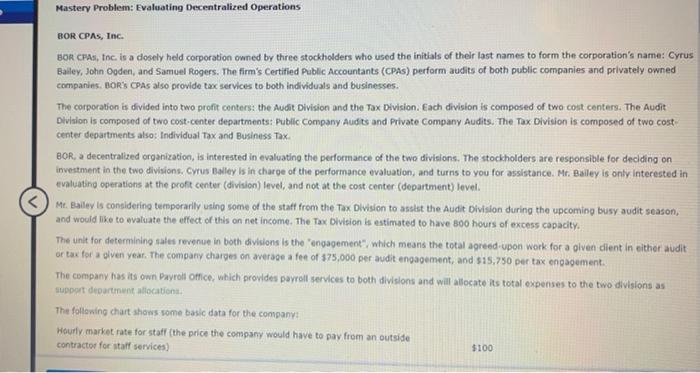
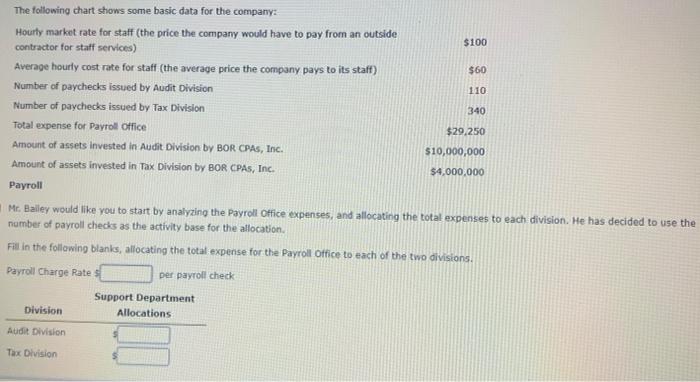
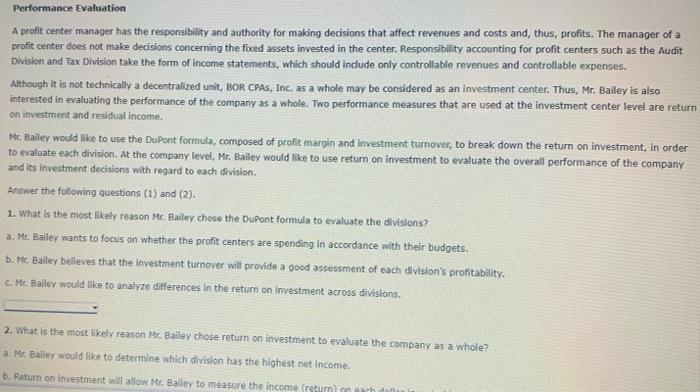
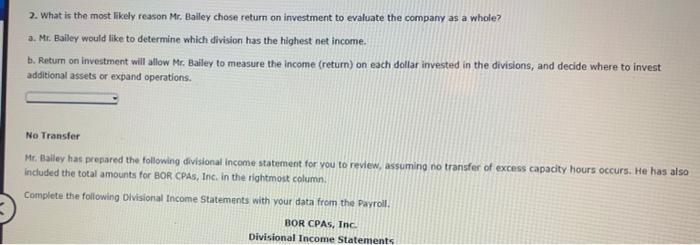
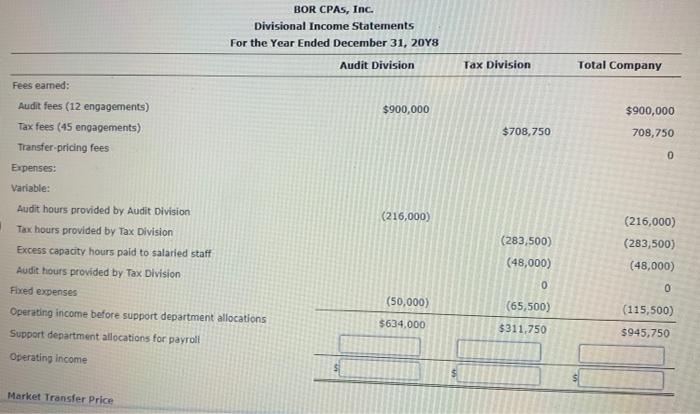

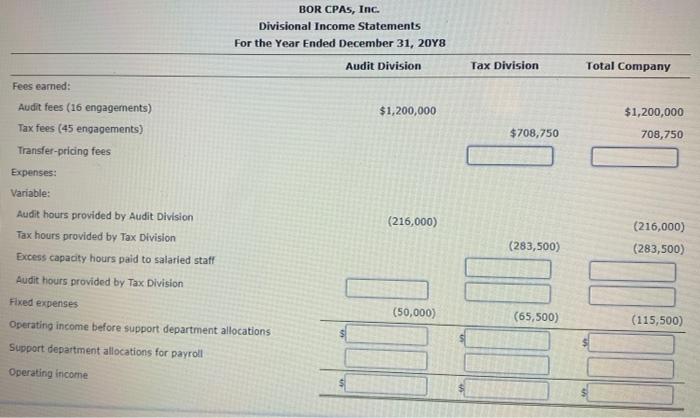

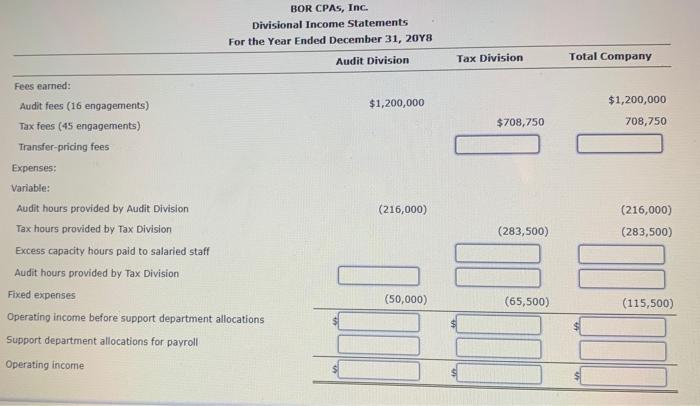

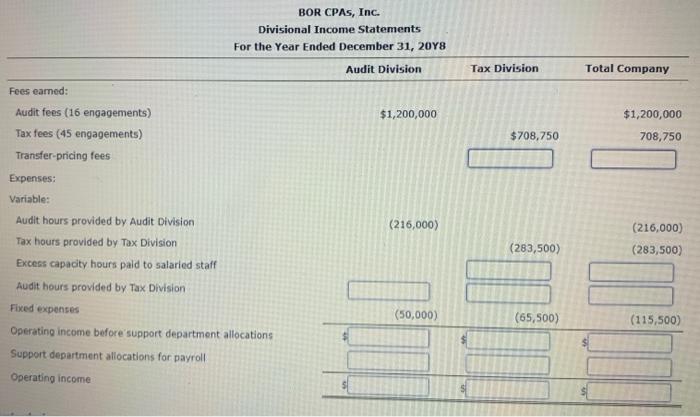
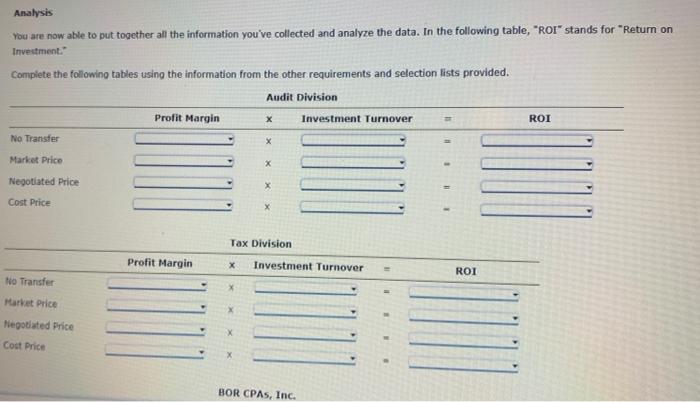
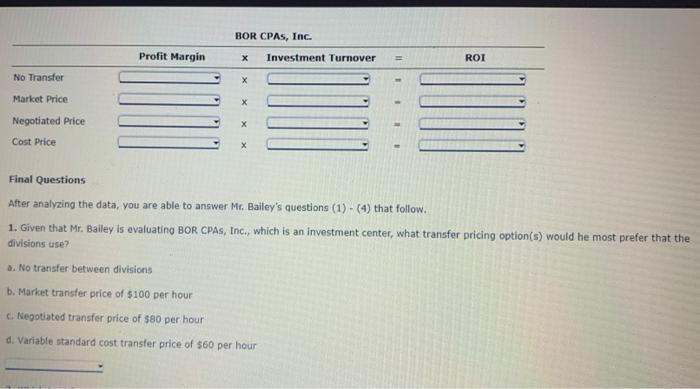
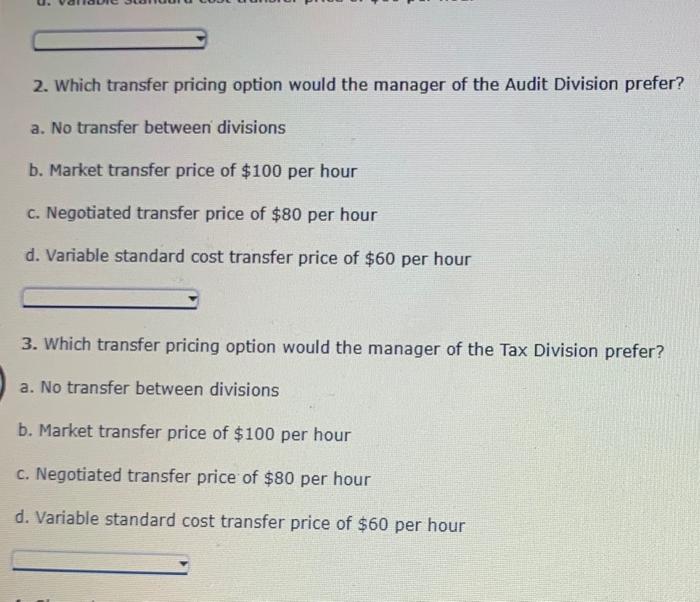
















if you are using the mobile app then you must zoom in to be able to read it. on a computer there is no need to zoom in
Mastery Problem: Evaluating Decentralized Operations BOR CPAS, Inc. BORCA, Inc. is a dosely held corporation owned by three stockholders who used the initials of their last names to form the corporation's name: Cyrus Balley, John Ogden, and Samuel Rogers. The firm's Certified Public Accountants (CPAS) perform audits of both public companies and privately owned companies. BOR'S CPAS also provide tac services to both individuals and businesses. The corporation is divided into two profit conters: the Audit Division and the Tax Division. Each division is composed of two cost centers. The Audit Division is composed of two cost-center departments: Public Company Audts and Private Company Audits. The Tax Division is composed of two cost center departments also: Individual tax and Business Tax BOR, a decentralized organization, is interested in evaluating the performance of the two divisions. The stockholders are responsible for deciding on investment in the two divisions. Cyrus Balley is in charge of the performance evaluation, and turns to you for assistance. Mt. Bailey is only interested in evaluating operations at the profit center (division) level, and not at the cost center (department) level Me. Bailey is considering temporarily using some of the staff from the Tax Division to assut the Audit Division during the upcoming busy audit season, and would like to evaluate the effect of this on net income. The Tax Division is estimated to have 800 hours of excess capacity. The unit for determining sales revenue in both divisions is the 'engagement", which means the total agreed upon work for a given dient in either audit or tax for a glven year. The company charges on average a fee of $75,000 per audit engagement, and $15.750 per tax engagement. The company has its own Payroll Office, which provides payroll services to both divisions and will allocate its total expenses to the two divisions as support department allocation The following chart shows some basic data for the companys Hourly market rate for staff (the price the company would have to pay from an outside contractor for staff services) $100 $100 $60 110 340 The following chart shows some basic data for the company Houtty market rate for staff (the price the company would have to pay from an outside contractor for staff services) Average hourly cost rate for staff (the average price the company pays to its staft) Number of paychecks issued by Audit Division Number of paychecks issued by Tax Division Total expense for Payroll Office $29.250 Amount of assets invested in Audit Division by BOR CPAS, Inc. $10,000,000 Amount of assets invested in Tax Division by BOR CPAS, Inc. $4,000,000 Payroll Mr. Bailey would like you to start by analyzing the Payroll Office expenses, and allocating the total expenses to each division. He has decided to use the number of payroll checks as the activity base for the allocation. Fill in the following blanks, allocating the total expense for the Payroll Office to each of the two divisions. Payroll Charge Rates per payroll check Support Department Division Allocations Audit Division Tax Division Performance Evaluation A profit center manager has the responsibility and authority for making decisions that affect revenues and costs and, thus, profits. The manager of a profit center does not make decisions concerning the fixed assets invested in the center. Responsibility accounting for profit centers such as the Audit Division and Tax Division take the form of income statements, which should indude only controllable revenues and controllable expenses. Although it is not technically a decentralized unit, BOR CPAS, Inc. as a whole may be considered as an investment center. Thus, Mr. Bailey is also interested in evaluating the performance of the company as a whole. Two performance measures that are used at the investment center level are return on investment and residual income. Mr. Bailey would like to use the DuPont formula, composed of profit margin and investment turnover, to break down the return on investment, in order to evaluate each division. At the company level, Mr. Bailey would like to use return on investment to evaluate the overall performance of the company and its investment decisions with regard to each division. Answer the following questions (1) and (2). 1. What is the most likely reason Mr. Bailey chose the DuPont formula to evaluate the divisions? a. Mt. Bailey wants to focus on whether the profit centers are spending in accordance with their budgets. b. Mr. Bailey believes that the investment turnover will provide a good assessment of each division's profitability. c. Mr. Salley would like to analyze differences in the retum on investment across divisions. 2. What is the most likely reason Mr. Bailey chose return on investment to evaluate the company as a whole? a. Mc Bailey would like to determine which division has the highest net income. b. Return on investment will allow Mr. Balley to measure the income returnench 2. What is the most likely reason Mr. Bailey chose return on investment to evaluate the company as a whole? a. Mt. Bailey would like to determine which division has the highest net income. b. Return on investment will allow Mr. Bailey to measure the income (return) on each dollar invested in the divisions, and decide where to invest additional assets or expand operations. No Transfer Mr. Bailey has prepared the following divisional Income statement for you to review, assumina no transfer of excess capacity hours occurs. He has also included the total amounts for BOR CPAS, Inc. in the rightmost column. Complete the following Divisional Income Statements with your data from the Payroll. BOR CPAs, Inc. Divisional Income Statements BOR CPAS, Inc. Divisional Income Statements For the Year Ended December 31, 2048 Audit Division Tax Division Total Company $900,000 $900,000 708,750 $708,750 0 Fees earned: Audit fees (12 engagements) Tax fees (45 engagements) Transfer pricing fees Expenses Variable: Audit hours provided by Audit Division Tax hours provided by Tax Division Excess capacity hours paid to salaried staff Audit hours provided by Tax Division Fixed expenses Operating income before support department allocations Support department allocations for payroll Operating Income (216,000) (216,000) (283,500) (48,000) (283,500) (48,000) 0 (65,500) $311,750 0 (50,000) (115,500) $634.000 $945,750 $ Market Transfer Price Market Transfer Price Mr. Bailey asks that you prepare Divisional Income Statements showing what 20Y8 results would have been had the Audit Division purchased all the excess capacity of the Tax Division, using a market transfer price. The divisional managers tell you that, with the excess capacity of the Tax Division of 800 hours, the Audit Division can perform 4 more audits during the year, and the Tax Division would charge the Audit Division the market rate of $100 per hour for the additional hours required, selling all its excess capacity to the Audit Division. The Tax Division would still be responsible for paying the salaries of their employees Complete the following Divisional Income Statements. If there is no amount or an amount is zero, enter"0" BOR CPAs, Inc. Divisional Income Statements For the Year Ended December 21 mm BOR CPAS, Inc. Divisional Income Statements For the Year Ended December 31, 2018 Audit Division Tax Division Total Company $1,200,000 $1,200,000 $708,750 708,750 (216,000) Fees eamed: Audit fees (16 engagements) Tax fees (45 engagements) Transfer pricing fees Expenses: Variable: Audit hours provided by Audit Division Tax hours provided by Tax Division Excess capacity hours paid to salaried staff Audit hours provided by Tax Division Fixed expenses Operating income before support department allocations Support department allocations for payroll Operating income (216,000) (283,500) (283,500) (50,000) (65,500) (115,500) Negotiated Transfer Price Mr. Bailey asks that you prepare Divisional Income Statements showing what 2078 results would have been had the Audit Division purchased all the excess capacity of the Tax Division, using a negotiated transfer price. The divisional managers tell you that, with the excess capacity of the Tax Division of 800 hours, the Audit Division can perform 4 more audits during the year and the Audit Division would agree to a negotiated rate of $80 per hour to be paid to the Tax Division for the additional hours required, with the Tax Division selling all its excess capacity to the Audit Division. The Tax Division would still be responsible for paying the salaries of their employees. Complete the following Divisional Income Statements. If there is no amount or an amount is zero, enter "0". BOR CPAS, Inc. Divisional Income Statements For the Year Ended Deromhnr 21 min BOR CPAS, Inc. Divisional Income Statements For the Year Ended December 31, 2018 Audit Division Tax Division Total Company Fees earned: $1,200,000 $1,200,000 $708,750 708,750 Audit fees (16 engagements) Tax fees (45 engagements) Transfer-pricing fees Expienses Variable: Audit hours provided by Audit Division Tax hours provided by Tax Division Excess capacity hours paid to salaried staff Audit hours provided by Tax Division (216,000) (216,000) (283,500) (283,500) Fixed expenses (50,000) (65,500) (115,500) Operating income before support department allocations Support department allocations for payroll Operating income Cost Transfer Price Mr. Balley asks that you prepare Divisional Income Statements showing what 20 results would have been had the Audit Division purchased all the excess capacity of the Tax Division, using a cost transfer price. The divisional managers tell you that, with the excess capacity of the Tax Division of 800 hours, the Audit Division can perform 4 more audits during the year, and the Audit Division would pay the Tax Division's internal hourly rate of $60 per hour for the additional hours required, with the Tax Division selling all its excess capacity to the Audit Division. The Tax Division would still be responsible for paying the salaries of their employees. Complete the following Divisional Income Statements. If there is no amount or an amount is zero, enter "0" BOR CPAS, Inc. Divisional Income Statements For the Year Ended December 31, 2018 BOR CPAs, Inc. Divisional Income Statements For the Year Ended December 31, 2018 Audit Division Tax Division Total Company $1,200,000 $1,200,000 708,750 $708,750 (216,000) Fees eamed: Audit fees (16 engagements) Tax fees (45 engagements) Transfer pricing fees Expenses: Variable: Audit hours provided by Audit Division Tax hours provided by Tax Division Excess capacity hours pald to salaried staff Audit hours provided by Tax Division Fixed expenses Operating income before support department allocations Support department allocations for payroll Operating income (216,000) (283,500) (283,500) (50,000) (65,500) (115,500) Analysis You are now able to put together all the information you've collected and analyze the data. In the following table, "Ror" stands for "Return on Investment." Complete the following tables using the information from the other requirements and selection lists provided. Audit Division Profit Margin Investment Turnover ROI No Transfer Market Price X X Negotiated Price Cost Price X Tax Division Profit Margin X Investment Turnover ROI No Transfer X Market Price Negotiated Price Cost Price X X BOR CPAS, Inc. BOR CPAS, Inc. Profit Margin Investment Turnover ROT No Transfer Market Price Negotiated Price Cost Price X X Final Questions After analyzing the data, you are able to answer Mr. Bailey's questions (1) - (4) that follow. 1. Given that Mr. Bailey is evaluating BOR CPAS, Inc., which is an investment center, what transfer pricing option(s) would he most prefer that the divisions use? a. No transfer between divisions b. Market transfer price of $100 per hour c. Negotiated transfer price of $80 per hour d. Variable standard cost transfer price of $60 per hour 2. Which transfer pricing option would the manager of the Audit Division prefer? a. No transfer between divisions b. Market transfer price of $100 per hour c. Negotiated transfer price of $80 per hour d. Variable standard cost transfer price of $60 per hour 3. Which transfer pricing option would the manager of the Tax Division prefer? a. No transfer between divisions b. Market transfer price of $100 per hour c. Negotiated transfer price of $80 per hour d. Variable standard cost transfer price of $60 per hour 4. Given the preferences of the managers of the Audit and Tax Divisions, and also considering the preferences of BOR CPAS, Inc., what might be the decision that provides the best outcome for all levels and entities within the company? a. Use the negotiated transfer price, so that each entity is better off than it would be without any transfers between divisions. b. If the divisional managers cannot come to an agreement, it's best to forgo any transfers between divisions in order to reduce coriflict within the company c. The company should use the market transfer price, since it's important for the divisions to operate under real market conditions. d. The company should use the variable standard cost transfer price, because it would be unfair for the Tax Division to make a profit in dealing with the Audit Division, since they're in the same company Mastery Problem: Evaluating Decentralized Operations BOR CPAS, Inc. BORCA, Inc. is a dosely held corporation owned by three stockholders who used the initials of their last names to form the corporation's name: Cyrus Balley, John Ogden, and Samuel Rogers. The firm's Certified Public Accountants (CPAS) perform audits of both public companies and privately owned companies. BOR'S CPAS also provide tac services to both individuals and businesses. The corporation is divided into two profit conters: the Audit Division and the Tax Division. Each division is composed of two cost centers. The Audit Division is composed of two cost-center departments: Public Company Audts and Private Company Audits. The Tax Division is composed of two cost center departments also: Individual tax and Business Tax BOR, a decentralized organization, is interested in evaluating the performance of the two divisions. The stockholders are responsible for deciding on investment in the two divisions. Cyrus Balley is in charge of the performance evaluation, and turns to you for assistance. Mt. Bailey is only interested in evaluating operations at the profit center (division) level, and not at the cost center (department) level Me. Bailey is considering temporarily using some of the staff from the Tax Division to assut the Audit Division during the upcoming busy audit season, and would like to evaluate the effect of this on net income. The Tax Division is estimated to have 800 hours of excess capacity. The unit for determining sales revenue in both divisions is the 'engagement", which means the total agreed upon work for a given dient in either audit or tax for a glven year. The company charges on average a fee of $75,000 per audit engagement, and $15.750 per tax engagement. The company has its own Payroll Office, which provides payroll services to both divisions and will allocate its total expenses to the two divisions as support department allocation The following chart shows some basic data for the companys Hourly market rate for staff (the price the company would have to pay from an outside contractor for staff services) $100 $100 $60 110 340 The following chart shows some basic data for the company Houtty market rate for staff (the price the company would have to pay from an outside contractor for staff services) Average hourly cost rate for staff (the average price the company pays to its staft) Number of paychecks issued by Audit Division Number of paychecks issued by Tax Division Total expense for Payroll Office $29.250 Amount of assets invested in Audit Division by BOR CPAS, Inc. $10,000,000 Amount of assets invested in Tax Division by BOR CPAS, Inc. $4,000,000 Payroll Mr. Bailey would like you to start by analyzing the Payroll Office expenses, and allocating the total expenses to each division. He has decided to use the number of payroll checks as the activity base for the allocation. Fill in the following blanks, allocating the total expense for the Payroll Office to each of the two divisions. Payroll Charge Rates per payroll check Support Department Division Allocations Audit Division Tax Division Performance Evaluation A profit center manager has the responsibility and authority for making decisions that affect revenues and costs and, thus, profits. The manager of a profit center does not make decisions concerning the fixed assets invested in the center. Responsibility accounting for profit centers such as the Audit Division and Tax Division take the form of income statements, which should indude only controllable revenues and controllable expenses. Although it is not technically a decentralized unit, BOR CPAS, Inc. as a whole may be considered as an investment center. Thus, Mr. Bailey is also interested in evaluating the performance of the company as a whole. Two performance measures that are used at the investment center level are return on investment and residual income. Mr. Bailey would like to use the DuPont formula, composed of profit margin and investment turnover, to break down the return on investment, in order to evaluate each division. At the company level, Mr. Bailey would like to use return on investment to evaluate the overall performance of the company and its investment decisions with regard to each division. Answer the following questions (1) and (2). 1. What is the most likely reason Mr. Bailey chose the DuPont formula to evaluate the divisions? a. Mt. Bailey wants to focus on whether the profit centers are spending in accordance with their budgets. b. Mr. Bailey believes that the investment turnover will provide a good assessment of each division's profitability. c. Mr. Salley would like to analyze differences in the retum on investment across divisions. 2. What is the most likely reason Mr. Bailey chose return on investment to evaluate the company as a whole? a. Mc Bailey would like to determine which division has the highest net income. b. Return on investment will allow Mr. Balley to measure the income returnench 2. What is the most likely reason Mr. Bailey chose return on investment to evaluate the company as a whole? a. Mt. Bailey would like to determine which division has the highest net income. b. Return on investment will allow Mr. Bailey to measure the income (return) on each dollar invested in the divisions, and decide where to invest additional assets or expand operations. No Transfer Mr. Bailey has prepared the following divisional Income statement for you to review, assumina no transfer of excess capacity hours occurs. He has also included the total amounts for BOR CPAS, Inc. in the rightmost column. Complete the following Divisional Income Statements with your data from the Payroll. BOR CPAs, Inc. Divisional Income Statements BOR CPAS, Inc. Divisional Income Statements For the Year Ended December 31, 2048 Audit Division Tax Division Total Company $900,000 $900,000 708,750 $708,750 0 Fees earned: Audit fees (12 engagements) Tax fees (45 engagements) Transfer pricing fees Expenses Variable: Audit hours provided by Audit Division Tax hours provided by Tax Division Excess capacity hours paid to salaried staff Audit hours provided by Tax Division Fixed expenses Operating income before support department allocations Support department allocations for payroll Operating Income (216,000) (216,000) (283,500) (48,000) (283,500) (48,000) 0 (65,500) $311,750 0 (50,000) (115,500) $634.000 $945,750 $ Market Transfer Price Market Transfer Price Mr. Bailey asks that you prepare Divisional Income Statements showing what 20Y8 results would have been had the Audit Division purchased all the excess capacity of the Tax Division, using a market transfer price. The divisional managers tell you that, with the excess capacity of the Tax Division of 800 hours, the Audit Division can perform 4 more audits during the year, and the Tax Division would charge the Audit Division the market rate of $100 per hour for the additional hours required, selling all its excess capacity to the Audit Division. The Tax Division would still be responsible for paying the salaries of their employees Complete the following Divisional Income Statements. If there is no amount or an amount is zero, enter"0" BOR CPAs, Inc. Divisional Income Statements For the Year Ended December 21 mm BOR CPAS, Inc. Divisional Income Statements For the Year Ended December 31, 2018 Audit Division Tax Division Total Company $1,200,000 $1,200,000 $708,750 708,750 (216,000) Fees eamed: Audit fees (16 engagements) Tax fees (45 engagements) Transfer pricing fees Expenses: Variable: Audit hours provided by Audit Division Tax hours provided by Tax Division Excess capacity hours paid to salaried staff Audit hours provided by Tax Division Fixed expenses Operating income before support department allocations Support department allocations for payroll Operating income (216,000) (283,500) (283,500) (50,000) (65,500) (115,500) Negotiated Transfer Price Mr. Bailey asks that you prepare Divisional Income Statements showing what 2078 results would have been had the Audit Division purchased all the excess capacity of the Tax Division, using a negotiated transfer price. The divisional managers tell you that, with the excess capacity of the Tax Division of 800 hours, the Audit Division can perform 4 more audits during the year and the Audit Division would agree to a negotiated rate of $80 per hour to be paid to the Tax Division for the additional hours required, with the Tax Division selling all its excess capacity to the Audit Division. The Tax Division would still be responsible for paying the salaries of their employees. Complete the following Divisional Income Statements. If there is no amount or an amount is zero, enter "0". BOR CPAS, Inc. Divisional Income Statements For the Year Ended Deromhnr 21 min BOR CPAS, Inc. Divisional Income Statements For the Year Ended December 31, 2018 Audit Division Tax Division Total Company Fees earned: $1,200,000 $1,200,000 $708,750 708,750 Audit fees (16 engagements) Tax fees (45 engagements) Transfer-pricing fees Expienses Variable: Audit hours provided by Audit Division Tax hours provided by Tax Division Excess capacity hours paid to salaried staff Audit hours provided by Tax Division (216,000) (216,000) (283,500) (283,500) Fixed expenses (50,000) (65,500) (115,500) Operating income before support department allocations Support department allocations for payroll Operating income Cost Transfer Price Mr. Balley asks that you prepare Divisional Income Statements showing what 20 results would have been had the Audit Division purchased all the excess capacity of the Tax Division, using a cost transfer price. The divisional managers tell you that, with the excess capacity of the Tax Division of 800 hours, the Audit Division can perform 4 more audits during the year, and the Audit Division would pay the Tax Division's internal hourly rate of $60 per hour for the additional hours required, with the Tax Division selling all its excess capacity to the Audit Division. The Tax Division would still be responsible for paying the salaries of their employees. Complete the following Divisional Income Statements. If there is no amount or an amount is zero, enter "0" BOR CPAS, Inc. Divisional Income Statements For the Year Ended December 31, 2018 BOR CPAs, Inc. Divisional Income Statements For the Year Ended December 31, 2018 Audit Division Tax Division Total Company $1,200,000 $1,200,000 708,750 $708,750 (216,000) Fees eamed: Audit fees (16 engagements) Tax fees (45 engagements) Transfer pricing fees Expenses: Variable: Audit hours provided by Audit Division Tax hours provided by Tax Division Excess capacity hours pald to salaried staff Audit hours provided by Tax Division Fixed expenses Operating income before support department allocations Support department allocations for payroll Operating income (216,000) (283,500) (283,500) (50,000) (65,500) (115,500) Analysis You are now able to put together all the information you've collected and analyze the data. In the following table, "Ror" stands for "Return on Investment." Complete the following tables using the information from the other requirements and selection lists provided. Audit Division Profit Margin Investment Turnover ROI No Transfer Market Price X X Negotiated Price Cost Price X Tax Division Profit Margin X Investment Turnover ROI No Transfer X Market Price Negotiated Price Cost Price X X BOR CPAS, Inc. BOR CPAS, Inc. Profit Margin Investment Turnover ROT No Transfer Market Price Negotiated Price Cost Price X X Final Questions After analyzing the data, you are able to answer Mr. Bailey's questions (1) - (4) that follow. 1. Given that Mr. Bailey is evaluating BOR CPAS, Inc., which is an investment center, what transfer pricing option(s) would he most prefer that the divisions use? a. No transfer between divisions b. Market transfer price of $100 per hour c. Negotiated transfer price of $80 per hour d. Variable standard cost transfer price of $60 per hour 2. Which transfer pricing option would the manager of the Audit Division prefer? a. No transfer between divisions b. Market transfer price of $100 per hour c. Negotiated transfer price of $80 per hour d. Variable standard cost transfer price of $60 per hour 3. Which transfer pricing option would the manager of the Tax Division prefer? a. No transfer between divisions b. Market transfer price of $100 per hour c. Negotiated transfer price of $80 per hour d. Variable standard cost transfer price of $60 per hour 4. Given the preferences of the managers of the Audit and Tax Divisions, and also considering the preferences of BOR CPAS, Inc., what might be the decision that provides the best outcome for all levels and entities within the company? a. Use the negotiated transfer price, so that each entity is better off than it would be without any transfers between divisions. b. If the divisional managers cannot come to an agreement, it's best to forgo any transfers between divisions in order to reduce coriflict within the company c. The company should use the market transfer price, since it's important for the divisions to operate under real market conditions. d. The company should use the variable standard cost transfer price, because it would be unfair for the Tax Division to make a profit in dealing with the Audit Division, since they're in the same company Step by Step Solution
There are 3 Steps involved in it
Step: 1

Get Instant Access to Expert-Tailored Solutions
See step-by-step solutions with expert insights and AI powered tools for academic success
Step: 2

Step: 3

Ace Your Homework with AI
Get the answers you need in no time with our AI-driven, step-by-step assistance
Get Started


